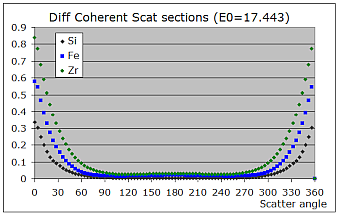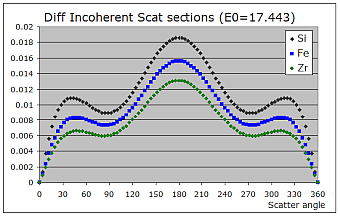2.6.2 Scattering
Scattering is conditioned by interactions of the x-ray photons with electrons. Inelastic (or Compton) scattering is the interaction of a photon with a free electron that can be considered at rest. The weak binding of electrons to atoms may be neglected if the momentum transferred to the electron greatly exceeds the momentum of the electron at bound state. Therefore, Compton scattering is predominant for low atomic number elements. As the result of the Compton scattering, the photon transfer some energy to the electron.
Rayleigh scattering occurs when the photons interact with bound atomic electrons and in which the atom is neither ionized nor excited. The incident photons are scattered with no loss of energy and with a definite phase relationship between the incoming and scattered waves. Rayleigh scatter occurs mostly at low energies and at high atomic number atoms.
Both coherent and incoherent scatter cross sections for a given element depend not only on the energy of the photon, but also on the angle of incidence. Scatter is therefore an anisotropic effect, and that property has to be taken into account when designing custom made instruments. The minimal cross sections for both types of scatter are observed at scattering angles of 90 and 270 degrees, and that´s the main reason for most of the instrumental arrangement geometries having the source and detector oriented under 90 degrees and each of them under 45 degrees regarding the sample surface.


